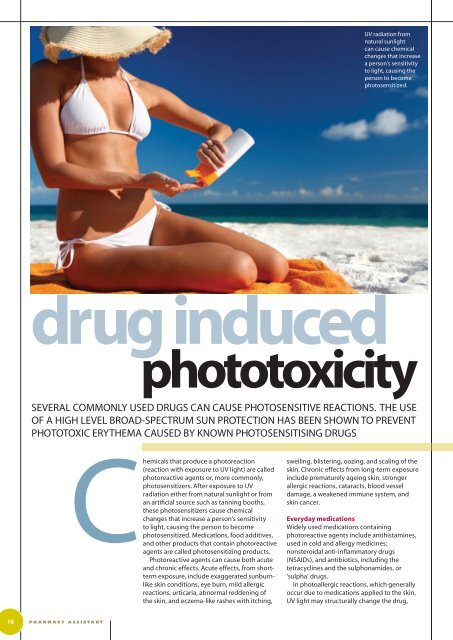Pharmacy Assistant - Green Cross Publishing
Pharmacy Assistant - Green Cross Publishing
Pharmacy Assistant - Green Cross Publishing
Create successful ePaper yourself
Turn your PDF publications into a flip-book with our unique Google optimized e-Paper software.
10<br />
pharmacy assistant<br />
C<br />
hemicals that produce a photoreaction<br />
(reaction with exposure to UV light) are called<br />
photoreactive agents or, more commonly,<br />
photosensitizers. After exposure to UV<br />
radiation either from natural sunlight or from<br />
an artificial source such as tanning booths,<br />
these photosensitizers cause chemical<br />
changes that increase a person’s sensitivity<br />
to light, causing the person to become<br />
photosensitized. Medications, food additives,<br />
and other products that contain photoreactive<br />
agents are called photosensitizing products.<br />
Photoreactive agents can cause both acute<br />
and chronic effects. Acute effects, from shortterm<br />
exposure, include exaggerated sunburnlike<br />
skin conditions, eye burn, mild allergic<br />
reactions, urticaria, abnormal reddening of<br />
the skin, and eczema-like rashes with itching,<br />
UV radiation from<br />
natural sunlight<br />
can cause chemical<br />
changes that increase<br />
a person’s sensitivity<br />
to light, causing the<br />
person to become<br />
photosensitized.<br />
drug induced<br />
phototoxicity<br />
SeVerAl CoMMoNly USeD DrUgS CAN CAUSe PhotoSeNSItIVe reACtIoNS. the USe<br />
of A hIgh leVel broAD-SPeCtrUM SUN ProteCtIoN hAS beeN ShoWN to PreVeNt<br />
PhototoxIC erytheMA CAUSeD by kNoWN PhotoSeNSItISINg DrUgS<br />
swelling, blistering, oozing, and scaling of the<br />
skin. Chronic effects from long-term exposure<br />
include prematurely ageing skin, stronger<br />
allergic reactions, cataracts, blood vessel<br />
damage, a weakened immune system, and<br />
skin cancer.<br />
Everyday medications<br />
Widely used medications containing<br />
photoreactive agents include antihistamines,<br />
used in cold and allergy medicines;<br />
nonsteroidal anti-inflammatory drugs<br />
(NSAIDs), and antibiotics, including the<br />
tetracyclines and the sulphonamides, or<br />
‘sulpha’ drugs.<br />
In photoallergic reactions, which generally<br />
occur due to medications applied to the skin,<br />
UV light may structurally change the drug,










